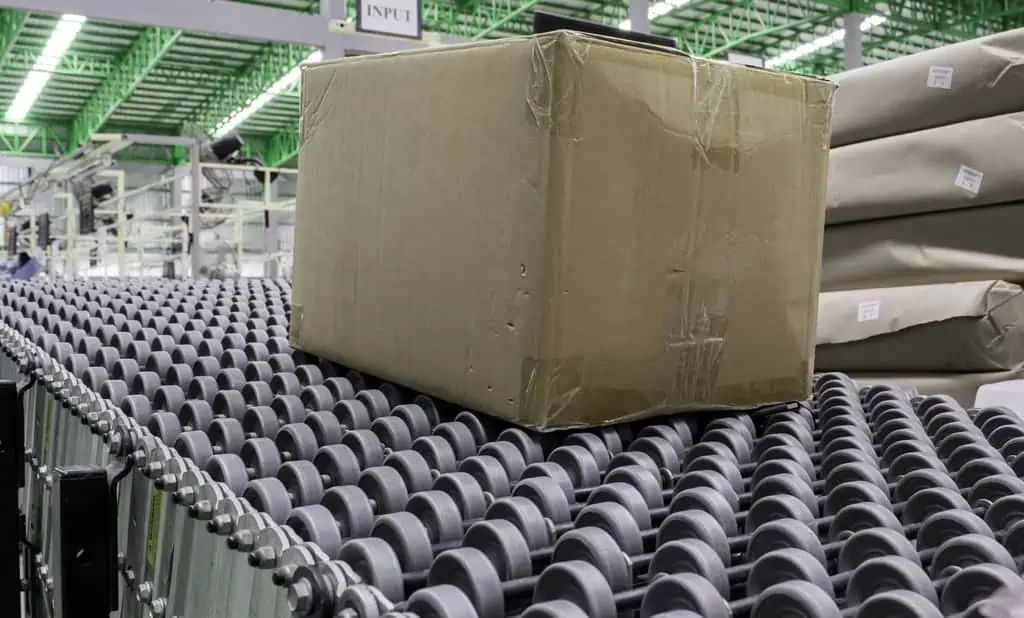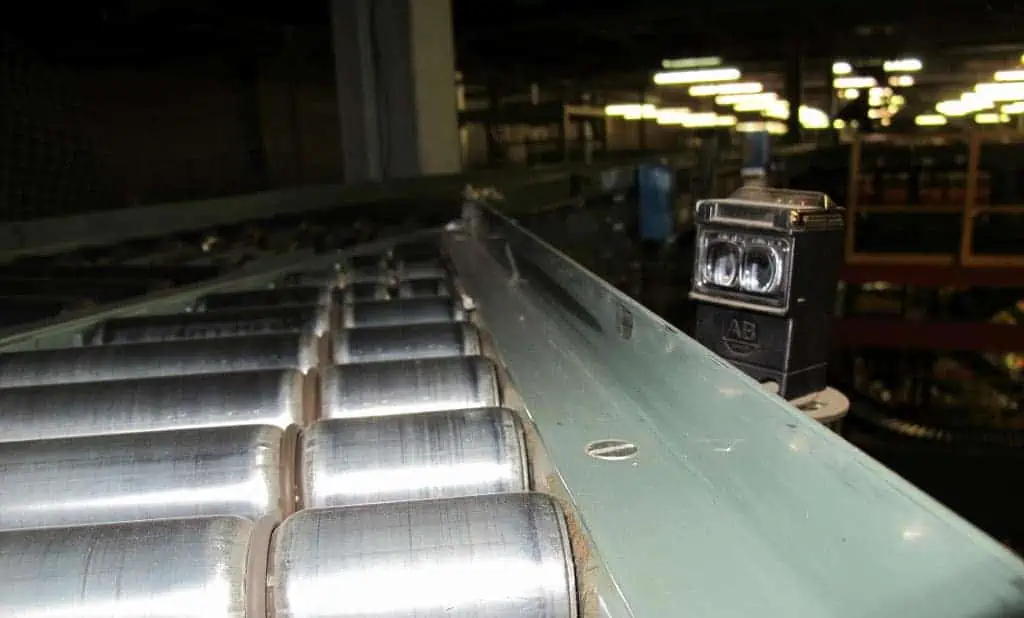The Difference Between Gravity and Power Conveyors
If you want to buy a conveyor — whether your first, additional or replacement — analyze these factors:
- How long does the conveyor need to be?
- Does it need to position items a particular way or maintain a space between items?
- What transfer rate does the conveyor need to be able to accommodate?
Knowing the specs of your warehouse or distribution center means these answers are easy to find. Here’s an additional question the team at East Coast Storage Equipment wants you to consider:
- Do you need a gravity conveyor or a power conveyor?
The differences between gravity and power conveyors can affect how your entire warehouse or distribution center operates. Make the wrong conveyor choice, and the job won’t get done or won’t get done efficiently.
Ready for some good news? We’re here to help. Our material handling experts have put together this simple guide to help you choose between a gravity conveyor or power conveyor system.
Read on to learn more.
What Is a Gravity Conveyor?
Conveyors are all about physics. The word “gravity” in “gravity conveyor” describes the physical force that moves products along the conveyor system. To put it simply, a gravity conveyor moves loads without the assistance of any powered source. Gravity is all it needs.
The basic idea of any conveyor system is to transport materials from one point to another. In the case of gravity conveyors, that can happen in a few ways. There are two main types of gravity conveyors:
1. Gravity Roller Conveyors
These conveyor systems use tube-shaped rollers mounted on individual axles longways between either side of the steel or aluminum conveyor frame. As materials move along the conveyor, the rollers rotate to allow forward movement from the force of gravity. The roller axles are typically spring-mounted to allow for some bending on the conveyor.
These conveyors are well-suited to heavier loads, such as drums, cans, canisters, barrels and lumber.
2. Gravity Skatewheel Conveyors
Skatewheel conveyors are similar to roller conveyors in how they move materials along the system, but instead of rollers, they use a system of small round wheels spaced and mounted on axles. As products move over the conveyor, the individual wheels rotate to allow the movement. Tube-shaped spacers between the wheels keep the wheels from moving from side to side and allowing the materials to tumble.

Skatewheel conveyors are common in the food and beverage industry, as well as any industry that can benefit from reducing the labor required to transport large numbers of lightweight items.
Other Types of Gravity Conveyors
Although roller and skatewheel conveyors are the most common types of gravity conveyor systems, there are other options. Many bend, curve and merge conveyor systems can operate via gravity. And, of course, there is the simplest gravity conveyor of them all: the chute conveyor. This conveyor looks like a slide on a playground — it’s just a declined metal chute that uses gravity and a low-friction internal surface to move materials from point A to point B.
What Is a Power Conveyor?
The key difference between gravity conveyors and power conveyors is how they generate movement. A power conveyor uses a source of power to move materials along the frame. Usually, this power source is an electric motor that moves either individual rollers or a tensioned belt.
Power conveyors can come in a lot of shapes and sizes, but the most common types are belt conveyors and roller conveyors.

1. Power Belt Conveyors
If you have ever waited for your luggage at baggage claim in a large airport, you have probably seen a great example of a power belt conveyor. Using an external electric motor and pulley system, these conveyor systems move items on a wide, flat belt over supports between the two sides of the conveyor frame. The supports are usually a smooth, flat surface or rollers.
Belt conveyors are typically best for moving lighter loads, such as packages, bulk materials and individual retail items.
2. Power Roller Conveyors
Power roller conveyors are highly similar to gravity roller conveyors. The primary difference is that power roller conveyors use an external powered mechanism to cause the rollers to rotate and move items along the line.
There are three common ways to rotate rollers in a power roller conveyor system:
- A belt on which the rollers rest
- A lineshaft, which is an external drive shaft attached to each roller via an O-ring
- A chain connected to each roller via sprockets
Each of the above options provides a different level of power. Belt-driven roller conveyors are best for lightweight objects that won’t need to travel up an incline. Lineshaft roller conveyors provide a little more power and allow the rollers to go either forward or backward. And chain-driven roller conveyors provide the most power, suiting them well for industries that deal with heavy loads.

Other Types of Power Conveyors
Many other types of power conveyor systems are designed to meet unique needs in various industries. Examples of other types of power conveyors are motorized roller conveyors, overhead conveyors and accumulation conveyors.
Gravity Conveyors vs. Power Conveyors
The descriptions of gravity vs. power conveyors above provide some clear differences between the two types of systems, but let’s take a closer look.
How They Move Products
The difference between gravity and power conveyors goes deeper than simply moving materials via gravity or power. For example, gravity conveyors can move items downhill, and with human assistance, they can move items across a level surface. But power conveyors can move items uphill or downhill and across a level surface with no human intervention.
Additionally, power belt conveyors will maintain space between items on the belt, while gravity conveyors cause items to accumulate after a decline or at the end of the line. Similarly, gravity conveyors cause items to move at varying speeds, depending on how steep the decline is. Meanwhile, power conveyors can maintain a consistent speed for all items throughout the system.

How Far They Can Reach
Gravity conveyors are best suited to move products short distances. While this is not a technical rule, keep in mind that high levels of decline or human assistance will be required to allow a gravity conveyor to move materials over a longer distance.
On the other hand, power conveyors can reach virtually any length you need them to. That’s because the system maintains equal power and speed over inclines, declines and flat surfaces for the entire length of the power conveyor.
Price Differences Between Gravity and Power Conveyors
While multiple factors will influence the price of a gravity conveyor or power conveyor, gravity conveyors will be more affordable as a general rule. The reason why is intuitive — gravity conveyors require no expensive motors and fewer parts, meaning they can have both a lower initial cost and lower maintenance costs over time.
There are, of course, further degrees of affordability within each category of conveyors. For example, gravity skatewheel conveyors tend to be less expensive than gravity roller conveyors. And systems that combine sections of power conveyor and sections of gravity conveyor can vary widely in price, depending on whether they are new or used and the various bends, curves, merges and other features they include.
Find the Perfect Conveyor for Your Warehouse or Distribution Center
The differences between gravity and power conveyors are clear, and they’re extremely important. If you’re still not sure which conveyor system is right for you, we’re here to help. The conveyor experts at East Coast Storage Equipment are ready to listen to your needs and match you with the perfect used conveyor system.
To speak with a member of our friendly and helpful team, give us a call at 732-451-1808 or contact us online.
Dear sirs
We need to modify our current roller conveyor to motorized rollers
I understand that you can modify the roller that drives the remain rollers via a groove where you link the remaining rollers
Who can I talk to regarding this request in more detail ?
Regards
Gildardo